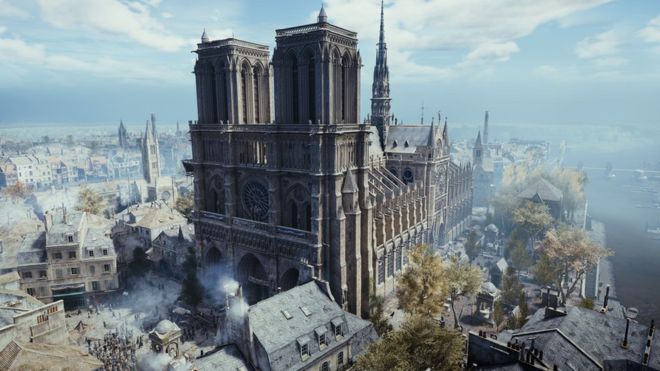
By Patrick Trujillo
It has been more than a week since the world stood aghast as fire ravaged the iconic French cathedral Notre Dame, and the world is still talking about it. It hardly comes as any surprise: this iconic place of worship has been a national landmark for the city of Paris for hundreds of years. Within a matter of hours, that landmark has been irreversibly changed. Donations are flooding in to help restore the cathedral to its former glory, but money can only accomplish so much. It will take extensive research and detailed reference materials to repair the damage done to Notre Dame. Much of this research has already been done: not by architects or historians, but by video game developers.
Much has been made of the 2014 video game Assassin’s Creed Unity and its painstakingly accurate recreation of Notre Dame, among other French landmarks. Ubisoft Level Artist Caroline Miousse spent two years working to recreate the cathedral inside and out, reports The Verge.
This level of accuracy is nothing new for Ubisoft, a company that employs historians to aid in the recreation of cities and landmarks in their games. Watch_Dogs, another Ubisoft title, is set in a fictional recreation of Chicago, while its sequel features San Francisco as its backdrop. Likewise, the critically acclaimed Spider-Man game from Insomniac is set in a lifelike recreation of the famed superhero’s New York City.
The fact that video game companies are willing to put in so many hours of work for the sake of bringing a real-world location to virtual life is a testament to the ever-evolving nature of the video game industry. What once was seen as mere entertainment in the days of Atari and Nintendo has since reached unparalleled levels of artistic expression. Much in the way that film and music have achieved a place in the broad range of artistic media, so have video games evolved to become a credible art form. Big-budget titles such as The Last of Us, as well as indie hits like Journey, stand as testaments to how far the medium has come since the days of Pong.
Now, with video game companies making greater efforts to translate our physical world into a virtual one, it only seems natural that video games can and should be considered as a credible resource for historical research. These virtual worlds are oftentimes nearly indistinguishable from our own, capturing our world within a time capsule. And like a time capsule, these games can be opened at any point in the future, allowing a glimpse into our world as it once appeared.
With the amount of research and labor that video game developers pour into recreating real-world spaces in the virtual world, video games are set to establish a new high score: the digital preservation of historic landmarks.






